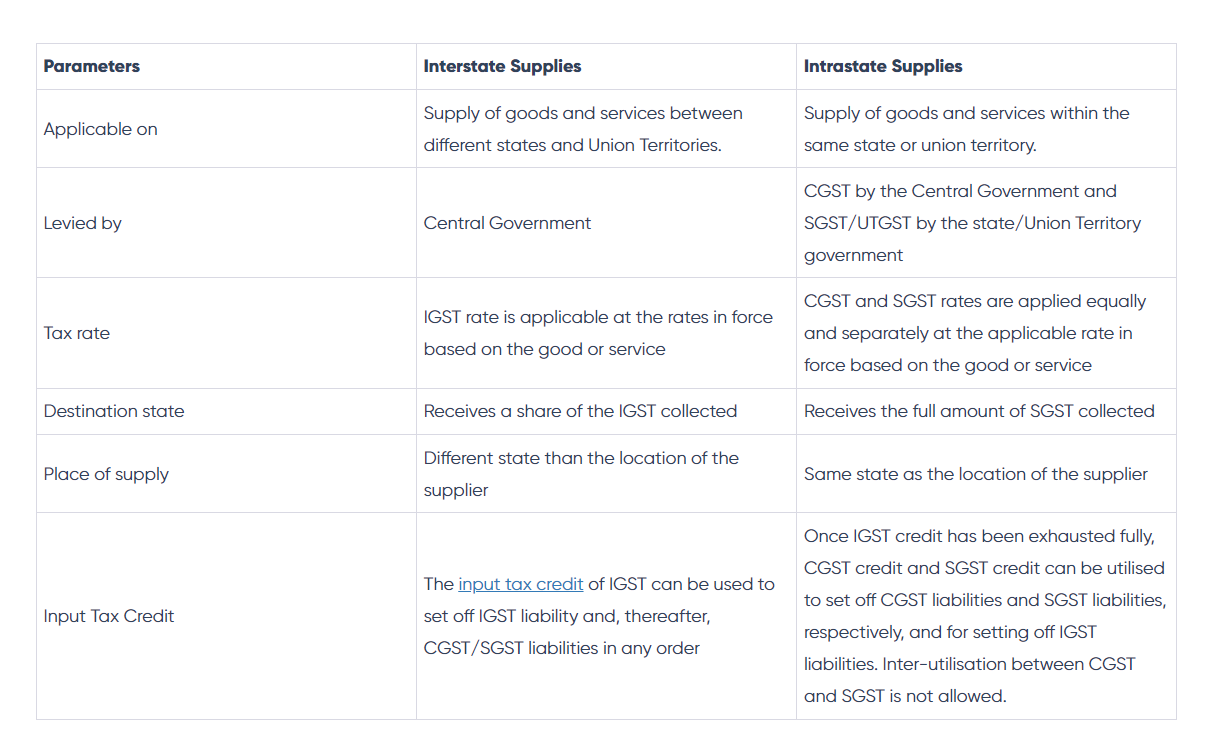Introduction
When the place of supply and the supplier of the products and services belong to the same state, if a supply is interstate, then the tax levied on the supply is SGST or UTGST and CGST. In the case of CGST and SGST, the tax is levied by the central government or state government, but when the tax is UTGST, it is levied by the UT governments.
CGST stands for Central Goods and Services Tax, SGST stands for State Goods and Services Tax, and UTGST stands for Union Territory Goods and Services Tax. Depending on what kinds of products or services are provided, the tax rate of intra-state supplies changes. In the case of intra-state transactions, the supplier needs to collect a combination of CGST and SGST from the buyer.
Definition Of Intra-State Supply
According to the GST Act, the intra-supply signifies the location of the buyer and the supplier of goods and services to be in the same state. So, in simple words, when the person supplying the goods and services and the buyer of that service or product are in the same state border, the supply is considered an intra-state supply.
In this type of supply, the government levies CGST and SGST. CGST gets to the central government, while the SGST is the property of the state government.
Transactions Within The Same State As Intra-State Supplies
To help you understand the concept of intra-state supply better, here are some examples —
Suppose a supply occurs between Kolkata, West Bengal, and Durgapur, West Bengal. In that case, the supply is considered intra-state supply because the supply is happening within one state, that is, West Bengal, in this example.
Now, when it comes to the math of the tax rate of intrastate supplies, it goes like this —
If we consider the supply is worth 10,000 rs and the GST levied upon it is 10%, out of which 5% is the CGST and the rest 5% is the SGST, then the total amount of GST which needs to be paid here is = 10,000 x 10% = 100 rs. If we divide it by 2, we will determine the CGST and the SGST separately, which is 50 rs.
The total amount of 100 rs is collected by the dealer and distributed to the central government as a CGST charge and to the state government or West Bengal (in this example) as an SGST charge, which is 50 rs here for both cases.
However, the amount both SGST and CGST add up to is the same amount that IGST is charged with. This is why no matter the nature of the supply – intra-state or interstate, the tax amount remains the same; the only difference is who levies the tax and how they levy it.
Characteristics Of Intra-State Supplies
Under the GST Act India, the main characteristics of intra-state supplies are —
- The primary characteristic that sets the core nature of the supply is the location of the supplier and the supply. If the product or service distribution is done from one place of a state to another palace of the same state, then the supply is tagged as intra-state supply. This supply can happen within the same territory of the country as well.
- When participating in the intra-state transaction of goods and services as a supplier or seller, one needs to get the SGST and CGST tax from the purchaser.
- The central government collects the SGST, and the state government collects the SGST.
Identifying Intra-State Supply Scenarios

Suppose a supply occurs between Jalalabad, Uttar Pradesh, and Faridpur, Uttar Pradesh. In that case, the supply is considered intra-state supply because the supply is happening within one state, Uttar Pradesh, in this example.
Also Read: GST Interstate Vs Intrastate Supply: What Is The Difference
Legal Aspects Of Intra-State Supply
Intra-state supply is the supply within a singular state, so some of the legal aspects of intra-state are —
- The supply is between two places in the same state or the same Union Territory.
- Some exceptions include supply between SEZ developer or SEZ unit.
- When the goods are imported to India or goods supplied to the tourist (referred to in section 15 of the IGST Act)
- The intra-state supply doesn’t include any kind of supply from or to special economic zone units and special economic zone developers.
- However, these legal aspects do not apply if the supply is export or import of goods when the supply comes under the provisions of IGST Act section 11.
Aside from this, if the location of either the buyer or the supplier is outside of India, then the place of supply is considered the same as the place of the supplier when the following services are provided —
- Any kind of services provided by the financial institute, banking institute, non-financial institute, or even account holders.
- When an intermediary provides the services.
- When the hiring means of transport are in question, those services also come under intra-state supplies.
- Some means of transport don’t come under this section, including aircraft and vessels. The time, in this case, is up to 1 month.
Intra-State Supply In GST Regulations
If the intra-state supply tax is mistakenly paid as an interstate supply tax, then that can lead to the incorrect tax payment. In the IGST Act section 19(1), if you had paid IGST instead of SGST and CGST while believing that your nature of supply was interstate when, in reality, it was intra-state, you are entitled to a full refund with few other conditions prescribed.
You also don’t need to pay any interest on that tax, but you need to pay the actual tax amount under the correct nature of supply.
Conclusion
The GST is the tax levied by the government of India, divided into different types depending on the nature of the supply in question. If the supply is intra-state, meaning the supply is happening within one state, then the GST applicable here is a combined amount of CGST and SGST.
Intra-state supplies do not include imports or exports in India, the SEZ developer, or unit zones. The SGST and CGST are divided equally and amount to the whole GST, the same amount as the IGST in that particular case. This means that only the nature of the supply changes and not the amount of the tax.
Also Read: How Is The Place Of Supply Determined For Intra-State Supplies?
FAQs
-
What is the difference between intrastate and interstate supply?
Intrastate supplies happen when the supplier and the purchaser are in the same state. Interstate supply happens from one state to another state, one state to another union territory, and vice versa, and one union territory to another.
-
What is the place of supply in intra-state supply?
Suppose a supplier is located in Bhuj, Gujarat, and the recipient of the supply is in Jamnagar, Gujarat. In that case, the place of supply will be the place of the supplier or where the product or service is shipped from in the beginning. In this case, the place of supply is Bhuj, Gujarat.
-
How are CGST and SGST distributed?
CGST and SGST are required for the intra-state supplies. The dealer needs to collect a combination of taxes from the buyer and give them to the central and state governments, respectively. However, the amount is equal between the CGST and the SGST, which means if one is paying a GST rate of 16%, then the SGST is 8% and the CGST is 8%.
-
What’s an example of intra-state supply?
Suppose there are two companies in Kolkata, one in Dum Dum and another in Park Street, and a supply of 50,000 rs of products is done from Park Street to Dum Dum. In that case, the supplier is the company in Park Street. The place of the supply is Dum Dum. If the CGST and SGST are implemented, and the total GST amounts to 10%, the buyer will pay 500 rs as GST. The supplier then takes the GST and submits it to the government, where it will be distributed among the central and state governments at a rate of 250 rs each.
-
Who collects the CGST, SGST, or UTGST?
The CGST is paid to the central government of India, the State government gets the SGST, and the Union Territory government gets the UTGST.
-
What does intra-state outward supply mean?
Intra-state outward supply means the place of supply and the location of the supplier are within the same state. However, there are exceptions, and that is when the supply happens between SEZ Unit B and SEZ Developer, which is also considered intra-state supply.
-
What is RCM in GST in Intra-Supply?
The full form of RCM in GST is the Reverse Charge Mechanism, and this indicates the situation when the RCM is paid to the government by the purchaser of the goods and services. In this case, the supplier doesn’t pay taxes, which is the typical mechanism of GST, which states that the supplier collects the GST from the purchaser and gives it to the government.
-
What is the Cess Tax in intra-state supply?
When one promotes education or health-related services, the tax levied on them is known as the cess tax. This tax is charged specially to benefit the development of that particular social area. “Cess” is taken from the original word “Assess,” but the spelling differs because of a past mistake in a census-related issue.
-
What happens if IGST is paid instead of CGST and SGST?
In the IGST Act section 19(1), if a person mistakenly paid the IGST tax instead of CGST and SGST because he believed the tax to be IGST, he would get a full refund of the money he paid. However, there will be other conditions that will be prescribed for such incidents.
-
Can you use SGST credit for CGST in intra-state supply?
No, you can not use the SGST input tax credit to fulfill the criteria of CGST liability. However, the liabilities regarding SGST can be paid by the SGST input tax credit. You can also pay your IGST liability from your SGST available credit balance.
